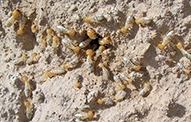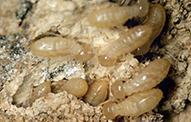DIY Termite Treatment
There is plenty of speculation around “Do-It-Yourself” (DIY) termite control. You might ask yourself, “Do DIY products and treatments work? Do I really need a termite warranty for my house? How do I ensure my home is protected long term against termites?” These are all common questions homeowners have when faced with an infestation, or deciding what can be done to prevent one.
The truth is there is no simple solution for termites. Factors such as the type of termite you have, your home’s layout, foundation type, building materials, climate, and conditions in and around your home all play an important role when determining the best treatment method to pursue.
Fighting termites successfully takes a unique understanding of termite behavior, biology, home construction and conditions in the home that are conducive to termite infestation. Termite control professionals receive extensive training, as well as on-going continuous education, and must be licensed in the state in which they are performing the service.
DIY methods may seem like a cost-effective option; however, damage caused to homes from ineffective treatment can cost homeowners thousands and is not covered under most homeowner’s insurance policies. It takes extensive knowledge, specialized equipment and up-to-date product knowledge on the part of the homeowner to treat termites successfully.
Another good reason to leave termite control to the pros is the warranty. Most professional termite control companies provide additional protection through a warranty protecting your home from future damage and covering the cost of treatment should termites return. Think of your termite warranty as your “insurance policy” against termites. Understanding what’s covered under your warranty is critical as not all termite warranties are created equal. Before embarking on trying to treat your home for termites on your own, talk to a Truly Nolen termite professional. Our termite inspections are usually free, and we can help you determine the scope of your termite problem. Truly Nolen is proud to offer a comprehensive termite warranty that covers all types of termites and up to $1 million in damage caused by termites to your home.
Common Types of DIY Termite Treatments
There are several types of treatment options homeowners themselves can use to treat for termites but, in general, they typically do not do enough to address the full scope of any termite problem. These common DIY treatments are typically applied as “spot treatments” and do not provide comprehensive protection against termites given the limited long-term residual protection they provide. In addition, there is no DIY method or off-the-shelf product purchased at a home improvement store that includes a warranty or will guarantee your home will remain protected against future infestations.
Orange Oil Treatments
When industries use oranges to create consumer goods, the acid from the rind is either mechanically or chemically extracted, producing a naturally-occurring oil called d-Limonene “orange oil.” Orange oil is found in various cleaning products, detergents, shampoos and mild insecticides. Although it is typically viewed as an “eco-friendly” alternative, orange oil treatments only last a few days after application and lack any long-term residual effects found in other types of treatments. In order to be effective, orange oil treatments must reach every termite in the colony. Given that most homeowners can’t reach, or even see, all active members of the colony, not only is re-infestation likely, but the termites just avoid the area that was treated and infest the areas where treatments were not applied.
Pros:
- Typically less expensive and more convenient compared to bait stations
- Low-toxicity, produces minimal residue and fume hazards
- “Eco-friendlier” product
Cons: - Only effective as “spot” treatment; cannot be used to treat all potentially infested wood in a structure, particularly inaccessible areas
- Lacks residual effect to kill and prevent future infestation and re-infestation is likely
- Ineffective in soil against Subterranean termites due to brief residual life
In order for the orange oil treatment to be successful, it typically requires that it is done in conjunction with other types of termite treatments to ensure that there is some form of long-term residual protection provided
Termite Bait & Bait Stations
Small amounts of edible material can be installed either above or below ground and are meant to attract and be consumed by active termites. In theory, termites feed on the bait and afterward return to their colony where they spread the termiticide to the rest of the colony. These stations work to kill off immature termites, disrupting the molting process, which leaves the colony with no workers and leads to eventual starvation. Baits at best suppress colonies and at worst provide no protection at all. This is especially true in drier climates where there is not enough moisture in the ground for the baits to be appetizing, or in moist climates they may bypass the bait entirely given there is so much moisture already in the ground.
In most cases bait treatments need to be combined with barrier treatments to be effective. Products purchased at hardware stores will generally recommend that you get a professional termite inspection, and should not be used in place of liquid treatments but in conjunction. Read labels closely as bait stations alone will not likely provide the level of protection you need.
Pros:
- Inexpensive
- No drilling is required.
- Amount of pesticide is limited to the confines of the bait station, putting no pesticides in or around the immediate vicinity of a home where active infestations may be present but not in plain view.
Cons:
- Timing: it can take months before termites find underground bait stations and spread them amongst a colony, which means certain level of feeding and damage can still occur indefinitely. This passive method of treatment leaves home owners vulnerable as termites continue to cause damage to the home.
- Installation: bait stations won’t be effective by simply placing a few in the ground and then playing the waiting game. The responsibility is on the homeowner to be both insightful installing and diligent in monitoring each station, two tasks characteristic of pest professionals.
- Some bait station products can fail to eliminate termites in an already infested structure.
Termite “Sprays”
There are several types of termite sprays available for use, ranging from aerosols, to foam aerosols, to injectable dusts.
Pros:
- Aerosol sprays are great for killing worker and winged swarmers on contact that are already in wood.
- Sprays that come with an applicator straw, especially foams, can sometimes reach inaccessible areas.
- Dust consists of small particles which allow for easy travel throughout wood, and easy termite-to-termite transmission.
- Foam is inexpensive, where one 20 oz. can produce roughly 20 quarts of foam.
Cons:
- Using sprays requires exact knowledge of where termite activity is occurring. This is problematic when that information is not known, or multiple areas are infested.
- Aerosol treatments alone will not be effective against subterranean termites.
Conditions Ideal for Termites
As a homeowner there are measures you can take to minimize the conditions that are conducive to termites to help reduce the likelihood of an infestation. It’s important to remember that despite your best efforts to help prevent an infestation they can and do often occur and it’s important to address an infestation immediately.
Wood-to-Ground Contact:
The Problem: Wood to ground contact provides termites with easy access to food and moisture. Typical areas where wood-to-soil contact are found include:
- Wooden decks/steps
- Lumber or firewood
- Wooden fences
- Rotting stumps, etc.
The Solution: Eliminate wood-to-soil contact wherever possible. This includes any wood that may have been pressure treated, as pressure treated wood is also vulnerable to attack. Here are some tips you can use to remedy this common problem:
- Paint exterior wood (wood panels, any type of trim, etc.)
- Remove wood piles/cellulose material close to home
- Insulate wood with concrete patio blocks or brick
Moisture Accumulation:
The Problem: Termites are attracted to moisture. If soil near foundation is moist, termites will naturally be attracted to it. Termites can easily enter your home through small cracks and crevices found within the foundation so steps should be taken to remove these conditions in and around the home. Typical areas where moisture can accumulate around the home:
- Leaking pipe
- Water runoff from gutters and downspouts
- Build up from improper ventilation in crawl spaces
- Leaking ACs
- Lawn sprinklers and irrigation systems where water pools
The Solution: In all cases steps should be taken to reduce conditions around the home where moisture is found accumulating. Water should be diverted from the foundation of the home to help ensure termites are not attracted to areas near the foundation. Steps you can take to reduce moisture accumulation:
- Address faulty piping immediately
- Slope soil around home so downhill drainage moves water away from structure at least 5 feet
- Inspect for constant sources of moisture (A/C drip lines, dripping spigots, and sprinklers)
- Make sure exit vents are properly routed away from home
The Bottom Line: Termites are both extremely destructive and extremely hard to eliminate. Whether you’re treating an existing problem, trying to identify a possible problem, or simply looking to fortify your home from swarming termites in the future, it is important to be aware of all the drawbacks of DIY treatments. It’s always in the best interest of homeowners to have a termite inspection by a state-licensed inspector. Truly Nolen offers inspections free of charge, so if you’re on the fence about DIY versus professional termite control, don’t hesitate to call your local Truly Nolen service office!
- Get Rid of Desert Termites
- Infestation and Damage
- Bites and Treatement



